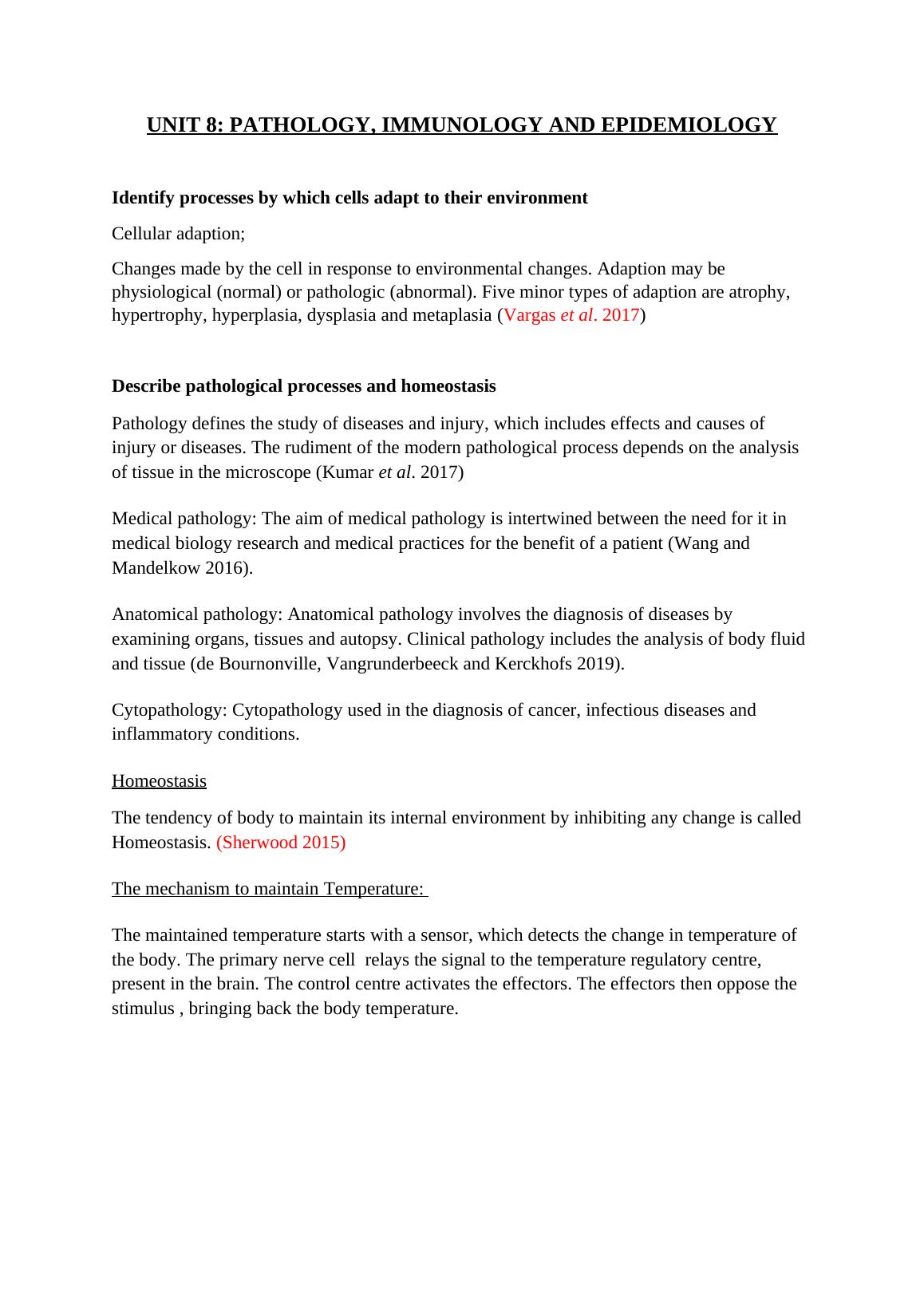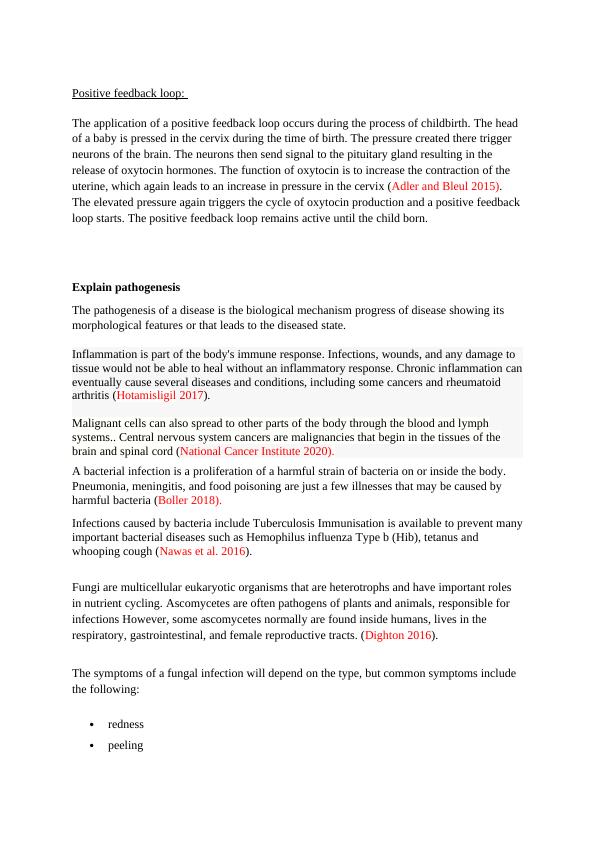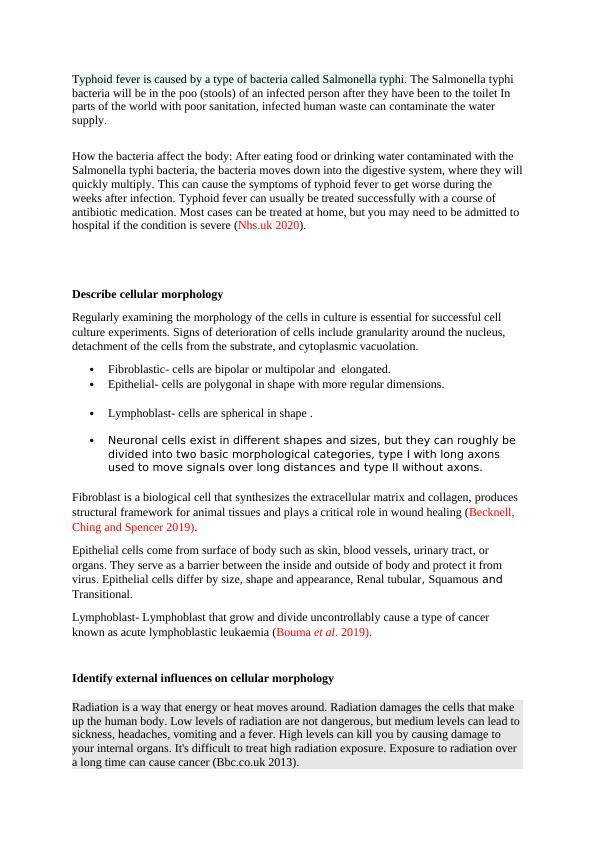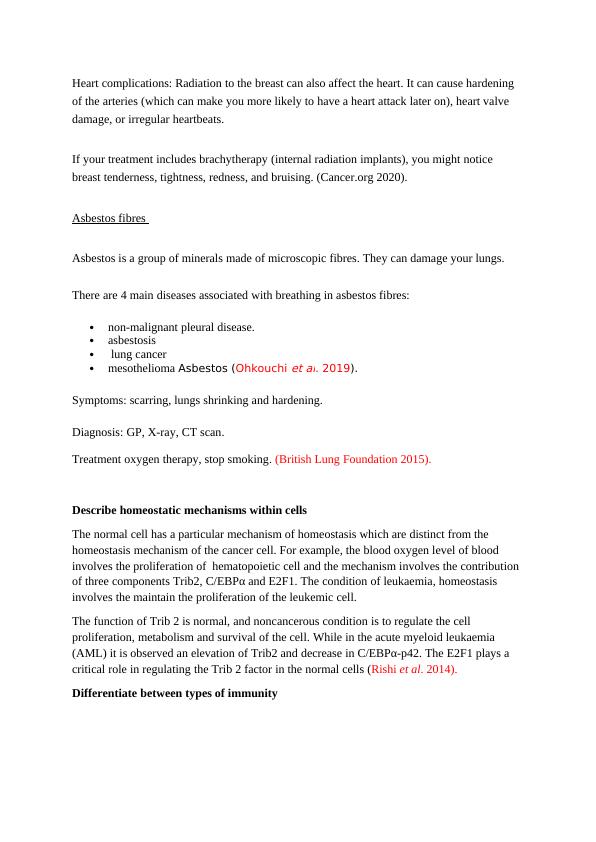Pathology Immunology And Epidemology
Added on 2022-08-12
12 Pages3877 Words21 Views
UNIT 8: PATHOLOGY, IMMUNOLOGY AND EPIDEMIOLOGY
Identify processes by which cells adapt to their environment
Cellular adaption;
Changes made by the cell in response to environmental changes. Adaption may be
physiological (normal) or pathologic (abnormal). Five minor types of adaption are atrophy,
hypertrophy, hyperplasia, dysplasia and metaplasia (Vargas et al. 2017)
Describe pathological processes and homeostasis
Pathology defines the study of diseases and injury, which includes effects and causes of
injury or diseases. The rudiment of the modern pathological process depends on the analysis
of tissue in the microscope (Kumar et al. 2017)
Medical pathology: The aim of medical pathology is intertwined between the need for it in
medical biology research and medical practices for the benefit of a patient (Wang and
Mandelkow 2016).
Anatomical pathology: Anatomical pathology involves the diagnosis of diseases by
examining organs, tissues and autopsy. Clinical pathology includes the analysis of body fluid
and tissue (de Bournonville, Vangrunderbeeck and Kerckhofs 2019).
Cytopathology: Cytopathology used in the diagnosis of cancer, infectious diseases and
inflammatory conditions.
Homeostasis
The tendency of body to maintain its internal environment by inhibiting any change is called
Homeostasis. (Sherwood 2015)
The mechanism to maintain Temperature:
The maintained temperature starts with a sensor, which detects the change in temperature of
the body. The primary nerve cell relays the signal to the temperature regulatory centre,
present in the brain. The control centre activates the effectors. The effectors then oppose the
stimulus , bringing back the body temperature.
Identify processes by which cells adapt to their environment
Cellular adaption;
Changes made by the cell in response to environmental changes. Adaption may be
physiological (normal) or pathologic (abnormal). Five minor types of adaption are atrophy,
hypertrophy, hyperplasia, dysplasia and metaplasia (Vargas et al. 2017)
Describe pathological processes and homeostasis
Pathology defines the study of diseases and injury, which includes effects and causes of
injury or diseases. The rudiment of the modern pathological process depends on the analysis
of tissue in the microscope (Kumar et al. 2017)
Medical pathology: The aim of medical pathology is intertwined between the need for it in
medical biology research and medical practices for the benefit of a patient (Wang and
Mandelkow 2016).
Anatomical pathology: Anatomical pathology involves the diagnosis of diseases by
examining organs, tissues and autopsy. Clinical pathology includes the analysis of body fluid
and tissue (de Bournonville, Vangrunderbeeck and Kerckhofs 2019).
Cytopathology: Cytopathology used in the diagnosis of cancer, infectious diseases and
inflammatory conditions.
Homeostasis
The tendency of body to maintain its internal environment by inhibiting any change is called
Homeostasis. (Sherwood 2015)
The mechanism to maintain Temperature:
The maintained temperature starts with a sensor, which detects the change in temperature of
the body. The primary nerve cell relays the signal to the temperature regulatory centre,
present in the brain. The control centre activates the effectors. The effectors then oppose the
stimulus , bringing back the body temperature.

Positive feedback loop:
The application of a positive feedback loop occurs during the process of childbirth. The head
of a baby is pressed in the cervix during the time of birth. The pressure created there trigger
neurons of the brain. The neurons then send signal to the pituitary gland resulting in the
release of oxytocin hormones. The function of oxytocin is to increase the contraction of the
uterine, which again leads to an increase in pressure in the cervix (Adler and Bleul 2015).
The elevated pressure again triggers the cycle of oxytocin production and a positive feedback
loop starts. The positive feedback loop remains active until the child born.
Explain pathogenesis
The pathogenesis of a disease is the biological mechanism progress of disease showing its
morphological features or that leads to the diseased state.
Inflammation is part of the body's immune response. Infections, wounds, and any damage to
tissue would not be able to heal without an inflammatory response. Chronic inflammation can
eventually cause several diseases and conditions, including some cancers and rheumatoid
arthritis (Hotamisligil 2017).
Malignant cells can also spread to other parts of the body through the blood and lymph
systems.. Central nervous system cancers are malignancies that begin in the tissues of the
brain and spinal cord (National Cancer Institute 2020).
A bacterial infection is a proliferation of a harmful strain of bacteria on or inside the body.
Pneumonia, meningitis, and food poisoning are just a few illnesses that may be caused by
harmful bacteria (Boller 2018).
Infections caused by bacteria include Tuberculosis Immunisation is available to prevent many
important bacterial diseases such as Hemophilus influenza Type b (Hib), tetanus and
whooping cough (Nawas et al. 2016).
Fungi are multicellular eukaryotic organisms that are heterotrophs and have important roles
in nutrient cycling. Ascomycetes are often pathogens of plants and animals, responsible for
infections However, some ascomycetes normally are found inside humans, lives in the
respiratory, gastrointestinal, and female reproductive tracts. (Dighton 2016).
The symptoms of a fungal infection will depend on the type, but common symptoms include
the following:
redness
peeling
The application of a positive feedback loop occurs during the process of childbirth. The head
of a baby is pressed in the cervix during the time of birth. The pressure created there trigger
neurons of the brain. The neurons then send signal to the pituitary gland resulting in the
release of oxytocin hormones. The function of oxytocin is to increase the contraction of the
uterine, which again leads to an increase in pressure in the cervix (Adler and Bleul 2015).
The elevated pressure again triggers the cycle of oxytocin production and a positive feedback
loop starts. The positive feedback loop remains active until the child born.
Explain pathogenesis
The pathogenesis of a disease is the biological mechanism progress of disease showing its
morphological features or that leads to the diseased state.
Inflammation is part of the body's immune response. Infections, wounds, and any damage to
tissue would not be able to heal without an inflammatory response. Chronic inflammation can
eventually cause several diseases and conditions, including some cancers and rheumatoid
arthritis (Hotamisligil 2017).
Malignant cells can also spread to other parts of the body through the blood and lymph
systems.. Central nervous system cancers are malignancies that begin in the tissues of the
brain and spinal cord (National Cancer Institute 2020).
A bacterial infection is a proliferation of a harmful strain of bacteria on or inside the body.
Pneumonia, meningitis, and food poisoning are just a few illnesses that may be caused by
harmful bacteria (Boller 2018).
Infections caused by bacteria include Tuberculosis Immunisation is available to prevent many
important bacterial diseases such as Hemophilus influenza Type b (Hib), tetanus and
whooping cough (Nawas et al. 2016).
Fungi are multicellular eukaryotic organisms that are heterotrophs and have important roles
in nutrient cycling. Ascomycetes are often pathogens of plants and animals, responsible for
infections However, some ascomycetes normally are found inside humans, lives in the
respiratory, gastrointestinal, and female reproductive tracts. (Dighton 2016).
The symptoms of a fungal infection will depend on the type, but common symptoms include
the following:
redness
peeling

Typhoid fever is caused by a type of bacteria called Salmonella typhi. The Salmonella typhi
bacteria will be in the poo (stools) of an infected person after they have been to the toilet In
parts of the world with poor sanitation, infected human waste can contaminate the water
supply.
How the bacteria affect the body: After eating food or drinking water contaminated with the
Salmonella typhi bacteria, the bacteria moves down into the digestive system, where they will
quickly multiply. This can cause the symptoms of typhoid fever to get worse during the
weeks after infection. Typhoid fever can usually be treated successfully with a course of
antibiotic medication. Most cases can be treated at home, but you may need to be admitted to
hospital if the condition is severe (Nhs.uk 2020).
Describe cellular morphology
Regularly examining the morphology of the cells in culture is essential for successful cell
culture experiments. Signs of deterioration of cells include granularity around the nucleus,
detachment of the cells from the substrate, and cytoplasmic vacuolation.
Fibroblastic- cells are bipolar or multipolar and elongated.
Epithelial- cells are polygonal in shape with more regular dimensions.
Lymphoblast- cells are spherical in shape .
Neuronal cells exist in different shapes and sizes, but they can roughly be
divided into two basic morphological categories, type I with long axons
used to move signals over long distances and type II without axons.
Fibroblast is a biological cell that synthesizes the extracellular matrix and collagen, produces
structural framework for animal tissues and plays a critical role in wound healing (Becknell,
Ching and Spencer 2019).
Epithelial cells come from surface of body such as skin, blood vessels, urinary tract, or
organs. They serve as a barrier between the inside and outside of body and protect it from
virus. Epithelial cells differ by size, shape and appearance, Renal tubular, Squamous and
Transitional.
Lymphoblast- Lymphoblast that grow and divide uncontrollably cause a type of cancer
known as acute lymphoblastic leukaemia (Bouma et al. 2019).
Identify external influences on cellular morphology
Radiation is a way that energy or heat moves around. Radiation damages the cells that make
up the human body. Low levels of radiation are not dangerous, but medium levels can lead to
sickness, headaches, vomiting and a fever. High levels can kill you by causing damage to
your internal organs. It's difficult to treat high radiation exposure. Exposure to radiation over
a long time can cause cancer (Bbc.co.uk 2013).
bacteria will be in the poo (stools) of an infected person after they have been to the toilet In
parts of the world with poor sanitation, infected human waste can contaminate the water
supply.
How the bacteria affect the body: After eating food or drinking water contaminated with the
Salmonella typhi bacteria, the bacteria moves down into the digestive system, where they will
quickly multiply. This can cause the symptoms of typhoid fever to get worse during the
weeks after infection. Typhoid fever can usually be treated successfully with a course of
antibiotic medication. Most cases can be treated at home, but you may need to be admitted to
hospital if the condition is severe (Nhs.uk 2020).
Describe cellular morphology
Regularly examining the morphology of the cells in culture is essential for successful cell
culture experiments. Signs of deterioration of cells include granularity around the nucleus,
detachment of the cells from the substrate, and cytoplasmic vacuolation.
Fibroblastic- cells are bipolar or multipolar and elongated.
Epithelial- cells are polygonal in shape with more regular dimensions.
Lymphoblast- cells are spherical in shape .
Neuronal cells exist in different shapes and sizes, but they can roughly be
divided into two basic morphological categories, type I with long axons
used to move signals over long distances and type II without axons.
Fibroblast is a biological cell that synthesizes the extracellular matrix and collagen, produces
structural framework for animal tissues and plays a critical role in wound healing (Becknell,
Ching and Spencer 2019).
Epithelial cells come from surface of body such as skin, blood vessels, urinary tract, or
organs. They serve as a barrier between the inside and outside of body and protect it from
virus. Epithelial cells differ by size, shape and appearance, Renal tubular, Squamous and
Transitional.
Lymphoblast- Lymphoblast that grow and divide uncontrollably cause a type of cancer
known as acute lymphoblastic leukaemia (Bouma et al. 2019).
Identify external influences on cellular morphology
Radiation is a way that energy or heat moves around. Radiation damages the cells that make
up the human body. Low levels of radiation are not dangerous, but medium levels can lead to
sickness, headaches, vomiting and a fever. High levels can kill you by causing damage to
your internal organs. It's difficult to treat high radiation exposure. Exposure to radiation over
a long time can cause cancer (Bbc.co.uk 2013).

Heart complications: Radiation to the breast can also affect the heart. It can cause hardening
of the arteries (which can make you more likely to have a heart attack later on), heart valve
damage, or irregular heartbeats.
If your treatment includes brachytherapy (internal radiation implants), you might notice
breast tenderness, tightness, redness, and bruising. (Cancer.org 2020).
Asbestos fibres
Asbestos is a group of minerals made of microscopic fibres. They can damage your lungs.
There are 4 main diseases associated with breathing in asbestos fibres:
non-malignant pleural disease.
asbestosis
lung cancer
mesothelioma Asbestos (Ohkouchi
et al. 2019).
Symptoms: scarring, lungs shrinking and hardening.
Diagnosis: GP, X-ray, CT scan.
Treatment oxygen therapy, stop smoking. (British Lung Foundation 2015).
Describe homeostatic mechanisms within cells
The normal cell has a particular mechanism of homeostasis which are distinct from the
homeostasis mechanism of the cancer cell. For example, the blood oxygen level of blood
involves the proliferation of hematopoietic cell and the mechanism involves the contribution
of three components Trib2, C/EBPα and E2F1. The condition of leukaemia, homeostasis
involves the maintain the proliferation of the leukemic cell.
The function of Trib 2 is normal, and noncancerous condition is to regulate the cell
proliferation, metabolism and survival of the cell. While in the acute myeloid leukaemia
(AML) it is observed an elevation of Trib2 and decrease in C/EBPα-p42. The E2F1 plays a
critical role in regulating the Trib 2 factor in the normal cells (Rishi et al. 2014).
Differentiate between types of immunity
of the arteries (which can make you more likely to have a heart attack later on), heart valve
damage, or irregular heartbeats.
If your treatment includes brachytherapy (internal radiation implants), you might notice
breast tenderness, tightness, redness, and bruising. (Cancer.org 2020).
Asbestos fibres
Asbestos is a group of minerals made of microscopic fibres. They can damage your lungs.
There are 4 main diseases associated with breathing in asbestos fibres:
non-malignant pleural disease.
asbestosis
lung cancer
mesothelioma Asbestos (Ohkouchi
et al. 2019).
Symptoms: scarring, lungs shrinking and hardening.
Diagnosis: GP, X-ray, CT scan.
Treatment oxygen therapy, stop smoking. (British Lung Foundation 2015).
Describe homeostatic mechanisms within cells
The normal cell has a particular mechanism of homeostasis which are distinct from the
homeostasis mechanism of the cancer cell. For example, the blood oxygen level of blood
involves the proliferation of hematopoietic cell and the mechanism involves the contribution
of three components Trib2, C/EBPα and E2F1. The condition of leukaemia, homeostasis
involves the maintain the proliferation of the leukemic cell.
The function of Trib 2 is normal, and noncancerous condition is to regulate the cell
proliferation, metabolism and survival of the cell. While in the acute myeloid leukaemia
(AML) it is observed an elevation of Trib2 and decrease in C/EBPα-p42. The E2F1 plays a
critical role in regulating the Trib 2 factor in the normal cells (Rishi et al. 2014).
Differentiate between types of immunity

End of preview
Want to access all the pages? Upload your documents or become a member.
Related Documents
Pathology of Clinical Manifestations in a Case Study of Urinary Tract Infectionlg...
|9
|2372
|78
